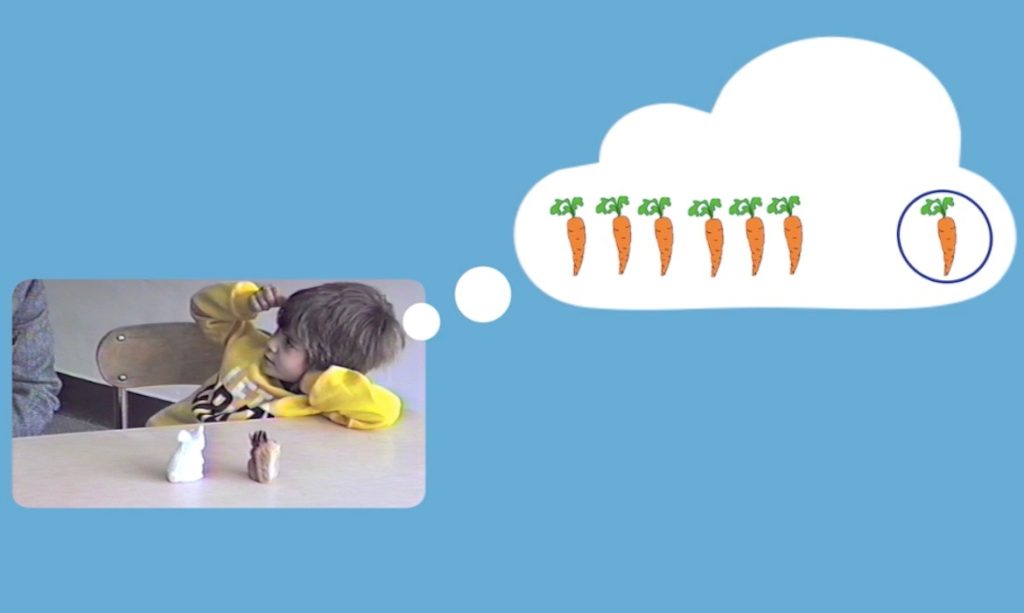- Understanding how children think can play an important role in promoting early math development.
- Videos that explain children’s thinking are useful for everyone who is interested in supporting early math teaching and learning.
- DREME developed a set of free video resources that explore children’s thinking around key early math concepts (links to the videos are at the end of this blog post).
A young child, Jennifer, is asked to solve a story problem. The rabbit has 3 carrots and the squirrel has 4 carrots. How many carrots do they have all together? Jennifer answers 6. How would you respond if you were her teacher or caregiver? You could say: “No, that’s wrong, the answer is 7.” Or what would happen if you focused on Jennifer’s thinking instead of on her mistake? What if you say instead: “How did you figure that out? I saw that you were counting a little.”
Focusing on Jennifer’s thinking, not on her mistake, opens a window into her mind. This is at the heart of math thinking conversations. The goal is to learn as much as possible about the child’s thinking by asking questions and responding flexibly to the child’s answers. These kinds of conversations can play an important role in children’s early math development.
Thinking About Thinking Can Be Fascinating
When we think about math, we often think about problem sets and formal schooling. However, young children are thinking about math long before then. From birth through age 5, children are developing an understanding of early math—including ideas of more and less, taking away, shape, size, location, pattern, and position—that is surprisingly broad, complex, and sometimes sophisticated. [1]
Videos illustrating children’s thinking help teachers learn to observe and interpret young children’s mathematical understanding. [2] With this in mind, we designed a set of DREME resources called Magic Math Minute videos. However, the videos are useful for everyone who is interested in supporting early math learning. [3] (Find links to the Magic Math Minute videos at the end of this blog post.)
The videos show young children exploring key early math concepts, including addition, spatial relations, measurement, and patterns. Since children love to read picture books, one video focuses on how math concepts can be discussed during shared reading. The videos show examples of how adults can encourage children to talk about their mathematical thinking.
Mistakes Help Us Learn
In the video scene described above, Jennifer considers the math problem: How many carrots do a rabbit and a squirrel have altogether? After answering incorrectly, Jennifer is prompted to explain how she figured out her answer. She works through the problem and explains the steps she took. Her responses show that while she got an incorrect answer, she understands how addition works. Then, while explaining her work, Jennifer actually spots her mistake and corrects herself.
To be sure, this is a happy result of the math thinking conversation. But getting the correct answer is not always the priority. Mistakes can help children grow and help the adults around them to support their children’s learning.
The goal is to find out how the child arrives at her answer and how the child thinks. Being aware of the child’s right and wrong answers is not enough; adults need to understand why the child got the right and wrong answers. It may be that the right answers are superficial and that the wrong ones are based on logic.
Ideas for Uncovering Children’s Thinking
Conversations around children’s math thinking can be brief and happen as part of everyday family and school conversations. Adults can present problems, ask questions, observe carefully, and listen. For example, one video shows how a simple question, Can you name something that is big? can lead to interesting conversations about measurement. One key feature of math thinking conversations is to follow the child’s response wherever it leads. If the child uses an unusual method to solve a problem or gives a surprising answer, explore the child’s thinking.
To encourage deeper thinking, try asking open-ended follow-up questions like: How do you know? How can we figure it out? What do you notice? Sometimes to figure out what a child knows, we have to keep asking questions and varying the ways in which we ask them.
Magic Math Minute Videos
Explore children’s thinking around important early math concepts with these video resources available on the DREME Teacher Educator website:
[1] Ginsburg, H., Lee, J. & Boyd, J. (2008). Mathematics Education for Young Children: What It Is and How to Promote It. Social Policy Report. 22. doi:10.1002/j.2379-3988.2008.tb00054.x.
[2] Ginsburg, H. P., Cami, Anne, E. C., & Preston, M. D. (2010). Beginnings: Inquiry practices: How can they be taught well? In Lyons (Ed.), Handbook of reflection and reflective inquiry: Mapping a way of knowing for professional reflective inquiry (pp. 453–472). New York, NY: Springer.
[3] Luna-Lucero, M., Oppenzato, C. O., Uscianowski, C., Almeda, M. V., & Ginsburg, H. P. (2020). “Magic math minute” videos to foster understanding of early mathematics learning. International Journal of Designs for Learning, 11(3), 47-66. doi:10.14434/ijdl.v11i3.27128



